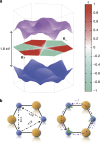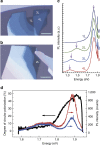Valley-selective circular dichroism of monolayer molybdenum disulphide
- PMID: 22673914
- PMCID: PMC3621397
- DOI: 10.1038/ncomms1882
Valley-selective circular dichroism of monolayer molybdenum disulphide
Abstract
A two-dimensional honeycomb lattice harbours a pair of inequivalent valleys in the k-space electronic structure, in the vicinities of the vertices of a hexagonal Brillouin zone, K(±). It is particularly appealing to exploit this emergent degree of freedom of charge carriers, in what is termed 'valleytronics'. The physics of valleys mimics that of spin, and will make possible devices, analogous to spintronics, such as valley filter and valve, and optoelectronic Hall devices, all very promising for next-generation electronics. The key challenge lies with achieving valley polarization, of which a convincing demonstration in a two-dimensional honeycomb structure remains evasive. Here we show, using first principles calculations, that monolayer molybdenum disulphide is an ideal material for valleytronics, for which valley polarization is achievable via valley-selective circular dichroism arising from its unique symmetry. We also provide experimental evidence by measuring the circularly polarized photoluminescence on monolayer molybdenum disulphide, which shows up to 50% polarization.
Figures




References
-
- Rycerz A., Tworzydlo J. & Beenakker C. W. J. Valley filter and valley valve in graphene. Nat. Phys. 3, 172–175 (2007).
-
- Akhmerov A. R. & Beenakker C. W. J. Detection of valley polarization in graphene by a superconducting contact. Phys. Rev. Lett. 98, 157003 (2007). - PubMed
-
- Xiao D., Yao W. & Niu Q. Valley-contrasting physics in graphene: Magnetic moment and topological transport. Phys. Rev. Lett. 99, 236809 (2007). - PubMed
-
- Yao W., Xiao D. & Niu Q. Valley-dependent optoelectronics from inversion symmetry breaking. Phys. Rev. B 77, 235406 (2008).
-
- Gunawan O. et al.. Valley susceptibility of an interacting two-dimensional electron system. Phys. Rev. Lett. 97, 186404 (2006). - PubMed
Publication types
MeSH terms
Substances
LinkOut - more resources
Full Text Sources
Other Literature Sources

